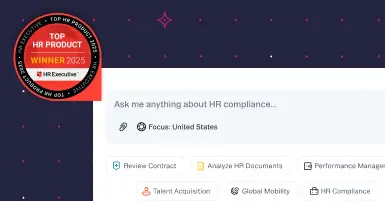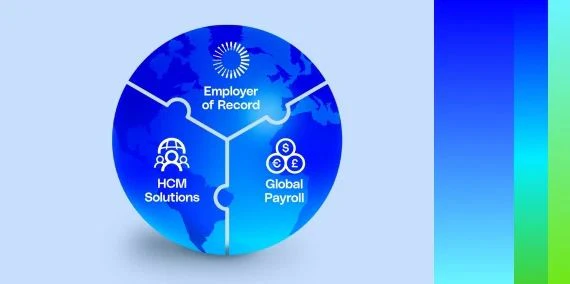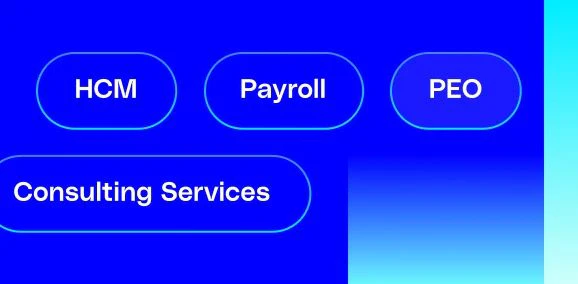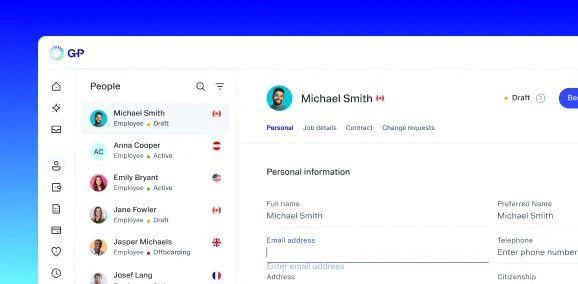An employer of record (EOR) simplifies global hiring and lets you sidestep the challenges of entity management. But moving from entity management to an EOR or switching providers is a huge decision that requires careful planning. This guide explains everything you need to know for a smooth transition.
Why transition to an EOR
Companies operating their own global entities may experience complex legal challenges and unexpected costs. Switching to an EOR offers several advantages:
-
Faster market entry: EORs let you hire and onboard talent in multiple countries within days, skipping the entity setup process.
-
Reduced administrative burden: EORs handle payroll, benefits, contracts, and ongoing compliance requirements, so internal teams can focus on core business activities.
-
Lower operational costs: Partnering with an EOR eliminates the ongoing expenses of maintaining a global entity, including local office space, legal fees, and compliance management.
-
Simplified compliance: EORs keep up with local labor laws and regulations, minimizing legal mistakes and penalties.
-
Scalable global expansion: EORs provide the flexibility to scale teams up or down based on your strategic priorities and market shifts.
-
Risk mitigation: An EOR acts as the legal employer and is responsible for adhering to local employment laws. This reduces the risk of noncompliance and related liabilities.
-
Market testing: The EOR model is quick, cost-effective, and flexible. It's ideal for testing new markets and makes it easy to scale or exit based on your needs.
-
Entity wind-down: If you want to close a local entity, you can transition employees to an EOR model to maintain continuity while cutting operational costs and complexity.
-
Global M&As: If your company is merging with or acquiring another company across borders, you may inherit a patchwork of contracts, payroll, and compliance challenges. An EOR handles the entire employment lifecycle for you, guaranteeing a smooth transition for everyone involved.
When to switch to a new EOR provider
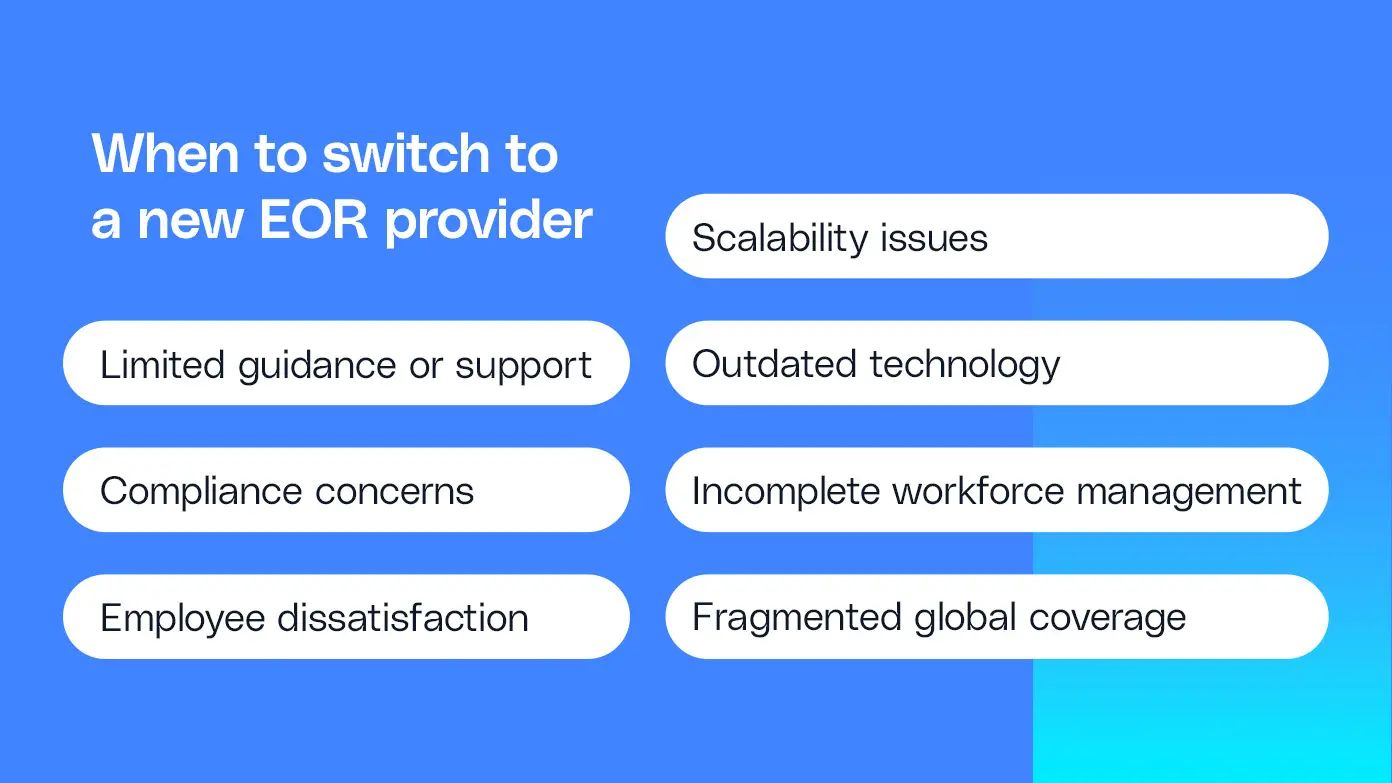
While EOR services offer many benefits, not all providers deliver the same level of service and results. Consider switching EOR providers if you experience:
-
Limited guidance or support: If your current EOR is slow to respond or doesn't give you clear, proactive guidance, look for a provider with stronger customer support. Quick response times and expert guidance help you manage your global team effectively.
-
Compliance concerns: If you're unsure about your EOR's ability to keep up with changing local regulations, you may need a partner with more expertise. Choose an EOR that combines expert legal and HR teams with cutting-edge AI technology to deliver the latest compliance insights.
-
Employee dissatisfaction: Payroll errors, benefits issues, or unclear HR policies harm your team's experience. Your EOR employees' satisfaction impacts productivity and retention, so choose a provider that can create a consistent employee experience that aligns with your values.
-
Scalability issues: If your EOR struggles to support your company's expansion into new regions, choose a more scalable solution that can grow alongside your business.
-
Outdated technology: Inefficient or outdated platforms cause bottlenecks in HR, payroll, and compliance. Switch to a more innovative EOR with a user-friendly interface and integrations with other best-in-class solutions.
-
Incomplete workforce management: Ensure your EOR can handle all worker types, including contractors, to simplify workforce management with a single provider.
-
Fragmented global coverage: If your EOR lacks reach or expertise in your hiring locations, switch to a provider with broader global infrastructure.
10 tips for transitioning to a new EOR
Whether you're transitioning to a new EOR from another provider or from your own entity, here's how to ensure a smooth changeover and maximize efficiency along the way:
-
Define roles and responsibilities: Assign tasks to your HR, finance, legal, and IT teams to coordinate the EOR transition. Clarify who is responsible for each task. A leading EOR can guide you through the transition while minimizing workload for your internal teams. Your new EOR can create updated contracts, migrate employee payroll information, transfer compliance documents, and communicate with your team members to reassure them that their role with your company is continuing.
-
Develop a transition timeline: Create a step-by-step plan with key milestones, notice periods, and deadlines for each phase of the EOR switch. Your new EOR can explain the timeline and support a quick transition.
-
Gather data: Collect all necessary employee and company information to share with your new provider. Choose an EOR who can centralize and secure this data. Essential information includes personal and contract data,compensation details, benefits information,and compliance documents.
-
Conduct a compliance and legal audit: A reputable EOR will review your contracts and employment terms against local standards to address any compliance gaps during the transition.
-
Communicate changes early: Inform employees about any changes to benefits, payroll, and employment terms as soon as possible to manage expectations and maintain trust.
-
Plan for leave management: Decide how to handle accrued paid time off and communicate options to employees. Options include a grace period to use PTO before the transition, a full leave payout, or coordinating with your new EOR to credit equivalent leave days to the employee in their system.
-
Terminate your current EOR agreement: Check all termination requirements in your contract with your current provider, if you have one. Gather all necessary data from their system, ensure they complete final payroll runs, and end the agreement.
-
Announce the EOR transfer company-wide: Announce the change to all employees and provide opportunities for questions and feedback. Focus messaging on the continuity of your company culture and daily work while highlighting the improvements you expect in HR administration.
-
Provide training: Ask your new EOR for resources to help employees and HR teams adapt to the new system. Ensure your teams know who to contact for support.
-
Enjoy ongoing support: Gather feedback from employees about their experience during and after the transition, and reach out to your new EOR for help resolving any challenges.
Experience seamless global employment with G-P™
If you're ready to experience world-class EOR services, choose G-P as your global hiring partner. As the industry leader in AI-powered EOR solutions, G-P combines cutting-edge technology with deep local expertise to deliver an unmatched global employment experience.
G-P EOR lets you hire quickly and compliantly in 180+ countries without the cost and complexity of managing your own local entity. We have a compliance record you can trust, backed by agentic AI that delivers instant compliance support and the industry's largest team of HR and legal experts. Our global employment technology has the flexibility to scale with you and the precision to create the same exceptional employee experience across worldwide teams.
As Nick Cheesman, Head of HR North America at Repsol, says, "Thanks to G-P's seamless transition process, we were able to focus on what matters most: our employees. What has impressed us significantly is G-P's human touch. The team demonstrates a genuine commitment to our success and the well-being of our employees."
Book a demo to switch to G-P and experience the confidence that comes from partnering with the #1 EOR provider.



